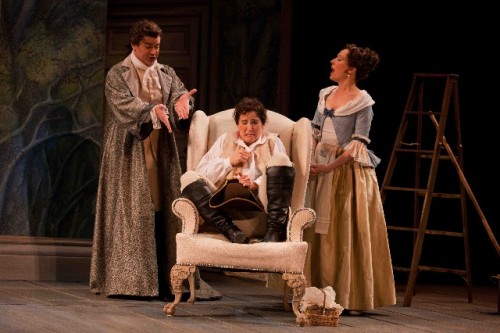Marriage of Figaro at Opera Colorado
Superb Staging by Comic Opera Expert David Gately
By: Susan Hall - Feb 16, 2012
The Marriage of Figaro
By Wolfgang Amadeus Mozart
Conducted by John Baril
Directed by David Gately
Cast: Keith Phares (Count Almaviva), Simone Alberghini (Figaro), Thomas Hammons (Doctor Bartolo), Dustin Peterson (Don Basilio), Patricia Risley (Cherubino), Christopher Besch (Antonio), James Baumgardner (Don Curzio), Twyla Robinson (Countess Almaviva), Ava Pine (Susanna), Julie Simson (Marcellina).
Opera Colorado
Ellie Caulkins Opera House
Denver Performing Arts Center
Denver, Colorado
February 12-19, 2012
Photos courtesy Opera Colorado
A crazy day in the life of Count Almaviva turns into a wonderful night of opera at the Ellie Caulkins Opera House, anchor of the Denver Performing Arts Center. Opened for the 1908 Democratic Convention, the opera house had a complete internal makeover 7 years ago. It is a magnificent, modern hall. With 2000 seats, the feel is still intimate. Wonderful looking panels of golden-bronze wood arc over the ceiling and walls. Dazzling to look out, they clearly function to provide a stellar acoustical experience for both singers and the audience.
With The Marriage of Figaro, playwright Pierre Beaumarchais launched modern opera, with a little help from Mozart, some joke. All the sparkle of high comedy and also the depth of affections make this opera great. During the course of the proceedings in Figaro, women get what they want, peasants get what they want, and in a final twist, the Count, who had fought so hard for the Countess in The Barber of Seville, seems happy to return to her and abandon his droit de seigneur at least for a night.
Figaro is based on a Beaumarchais play that was suppressed for six years because it portrayed revolutionary ideas. The night it opened, almost five thousand people stood in line, some of them crushed to death as they waited to purchase tickets.
Mozart chose the play for an opera. Not only is the music sublime, but the story, in which commoners triumph over the aristocrats, is one that most people cheer. Privilege versus ingenuity is a battle waged by every generation.
The opera has the advantage of having a grand setting in a Count’s domain, even though it starts in a servants’ bedroom. Costumes, wigs and the outlines of a palatial residence make this a period piece, fresh as it seems in performance.
Wallpaper varies from room to room. Nudes capering in Figaro and Susanna’s marital bower provide a petting zoo for the hormone-driven teen Cherubino when he can’t find a real breast or avoirdupois. The pictures in the background become more subdued as the opera progresses, moving from the Countess’s boudoir to courtly rooms and finally a garden.
Simone Alberghini's Figaro is richly hued, a romantic and yet a worthy foil to the Count. Alberghini accommodated the tricky plot turns with surety and fit the contemporary feel of the direction with seeming ease in his hearty baritone. At one point, he asks the count what he has done to deserve so many honors. It is clear that Alberghini deserves his. Keith Phares as the Count vocalized beautifully and also displayed the appropriate smarminess. Pitted in the battle against his Figaro, the quick-witted servant wins.
Patricia Risley was a knockout as Cherubino. As the mother in Leonard Bernstein’s A Quiet Place, performed by the New York City Opera, she displayed a lush, but pure voice that could turn on a dime dramatically.
In Boston in 2010 she performed the venturesome Death and the Powers by Tod Machover, which premiered in Monte Carlo. Her talent swings well from post-modern to Mozart. Her two arias: “What is this feeling that makes me so sad” and “I don’t know anymore what I am doing” are sure fire hits that she sang as hits.
True to Beaumarchais, the countess, Twyla Robinson, is tender and delicate. Stooping to seek the help of her servant, she sings her aria “Heavens to what a humiliating condition I have been reduced” with an anguished beauty. She manages to be both aristocratic and very human.
Ava Pine debuts as Susanna with flair. She is pertly tingling but not too saucy, just provocative. Her movements and voice are nimble and subtle, her personality winning. In the short duet with the Countess, they were touchingly joined.
Thomas Hammons as Dr. Bartolo was the comic hit of the evening. No surprise since he had been a hit in Menotti’s Last Savage in Santa Fe last summer. He can both sing and is great fun to watch. The cast were all superbly fitted to their roles, in part because the direction was swift and to the point.
In fact, David Gately directed one of the very best Figaro’s I have seen. The comic touches, the physicality of movement to music, the charm and inventiveness of some of the really silly, but delightful plot devices all worked. It is difficult to imagine that performers coming from such different backgrounds could be woven together in one Figaro, but they are in Denver, and for this Gately deserves credit.
John Baril displays the great clarity and charm of the score. Tempos were lively, but never pushed to uncomfortable speeds, and slower arias were given their full breadth without ever becoming heavy, slow or marmoreal. Clarity between strings and woodwinds was exemplary. Katharine Kozak at the harpsichord provided period texture.
Le Nozze di Figaro was composed by Mozart at the command of Emperor Joseph II of Austria. After congratulating the composer at the end of the first performance, the Emperor said: "You must admit, however, my dear Mozart, that there are a great many notes in your score." "Not one too many, Sire," was Mozart’s reply.
Subtle wit, comic mastery, and vivacious dialogue shone. At the end of the Opera Colorado production, you only wished for more.




